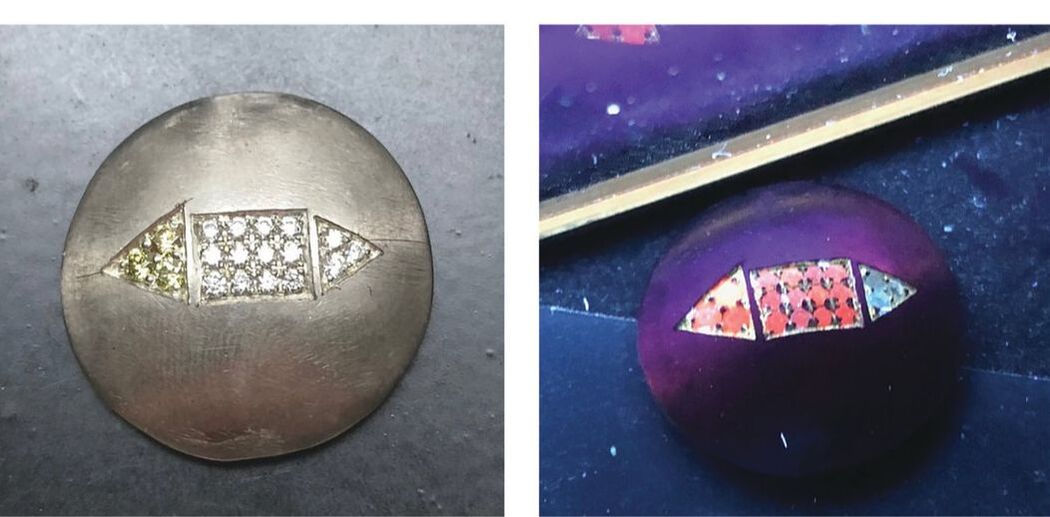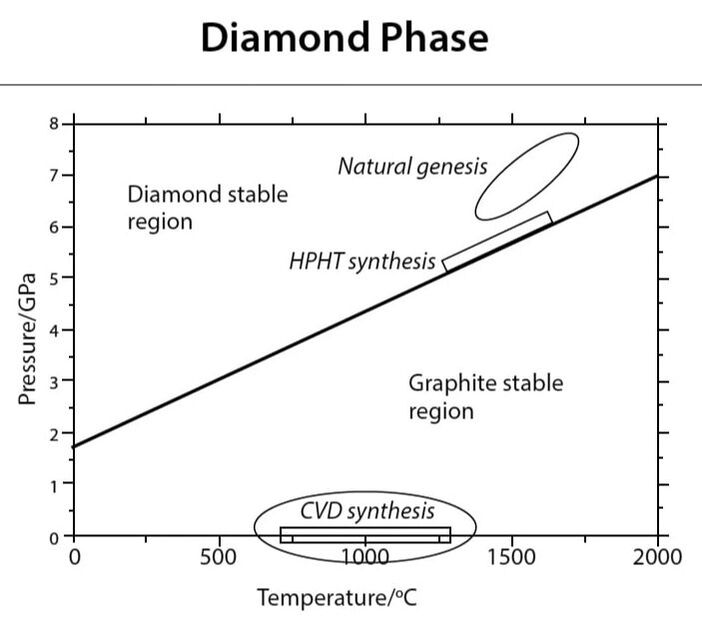
The authors of the book,
Branko Deljanin (left) and
Dusan Simic, together
have published more than
100 gemological articles
and presented papers at
major conferences and
events around the world.
Simic is CEO of New York-based
Analytical Gemology
and Jewelry. Deljanin is
president of CGL Canadian
Gemlab in Vancouver

Modern phase diagram for carbon (Bundy F P, Bassertt W A, Weathers M S, et al. 1966 Carbon 34, 141). The equilibrium line between diamond and graphite is defined by Berma-Sion calculations published in 1955. A commercial HPHT synthesis of diamond from graphite with solvent-catalysts. Discussed on page 41.
|
One of the fastest growing sectors in the gem and jewelry industry over the last two decades has undoubtedly been that of laboratory-grown diamonds (LGDs).
It is a topic that incites both appreciation and controversy, as well as consuming a great deal of ink in the trade and consumer press around the globe. Realizing early on the importance of LGDs and the necessity to understand the process, the results, uses, gemology, and the need to distinguish them from their mined counterparts, gemologists and diamond researchers Dusan Simic and Branko Deljanin published Laboratory-Grown Diamonds, a comprehensive tome on the subject in 2007, which itself built on built on a first edition, Laboratory-Created Diamonds, published in 2004. This 2007 Second Edition quickly became the go-to reference on these man-made gems. It received high acclaim from the industry and was translated into two languages. Over the last 13 years, however, there have been a number of important changes in the lab-grown sector, and thanks to overwhelming demand, Simic and Deljanin have come out with their Third Edition of Laboratory-Grown Diamonds, published in 2020. The updates include articles contributed by four eminent authors in the field: Dr. Boris Feigelson, a scientist at the U.S. Naval Research Laboratory in Washington D.C. who developed the BARS diamond growth technology; Malay Hirani, a process engineer from Mumbai, India and founder of Soni CVD Diamonds; Frank Ripka, an industrial engineer, and CEO of Algordanza’s subsidiaries in Germany and Austria; and Sharrie Woodring, senior gemologist at GCAL and co-author of the 2004 edition of this book with Branko Deljanin. One of the questions the 188-page Third Edition addresses is why these man-made stones are generating more attention than ever. The authors give three reasons: (1) manufacturers have refined the HPHT and CVD methods to produce a large supply of bigger gem-quality material at a reasonable cost; (2) more near-colorless, blue, and pink laboratory-grown diamonds are now available in addition to yellow, thanks to better growth conditions; (3) producers and U.S. designers are creating more jewelry with LGDs that are being carried by increasing numbers of retailers, thus initiating increased demand among consumers who are savvy about spending. Even though the book is quite technical in many aspects, most explanations are easy to understand and offer a good overview of the lab-grown sector. Part I provides a background on the industry, starting with the history of LGDs, which were first created in 1954 for industrial purposes, followed in the 1970s for gem-quality stones. It also explains the types of diamonds, as well as the evolution of the technologies involved in the HPHT and CVD processes as well as the changing colors of lab-grown stones. Important, too, is the information provided about the FTC guidelines regarding nomenclature of lab-grown diamonds. The FTC acknowledges that both mined and LGDs are diamonds with the difference being the source and that each be clearly labeled. Designed for transparency and to protect consumers, the new guidelines interestingly omit the word natural from the definition of a diamond. Part II offers a 2020 overview of diamond growth and production, along with the major producers around the world. The authors also describe the challenges for new companies considering getting into CVD-growing, including controlling intellectual property, training operators, budgets, start-up costs and more. One rather unique section goes into detail about LGDs known as Memorial Diamonds. "For a comparatively small but determined clientele, Memorial Diamonds provide intrinsic and sentimental value that infinitely surpasses its material value," write the authors, who state that these gems were first grown in 2003 using the HPHT method, and are marketed worldwide either in the funeral sector with carbon extracted from cremation remains or from hair of the deceased person. They note that these gems are also marketed as special items in the context of celebrations such as weddings where the carbon source is hair from a living person. They caution, however, that the overall process is not simple and that prospective buyers of Memorial Diamonds should deal only with reputable companies. Part III (64 pages, 1/3 of the book) is devoted to the identification of lab-grown diamonds, including descriptions and discussions of standard and advanced gemological equipment, as well as updates on fluorescence of both mined and LGDs. The last section of the book, Part IV, goes into detail on certification and tracking. It also includes a brief description of the unique USPTO patent obtained in 2018 by Dusan Simic ─ "Synthetic Diamond Labeling and Identification System and Method" ─ which is the first comprehensive solution to create simple intrinsic differences between natural and lab-grown diamonds used in the jewelry industry. The important issue of grading lab-grown diamonds is also discussed in this section. The book features a selection of beautiful jewelry made with LGDs in various colors by designers who are adopting these gems as an important part of their collections, especially in the demi-fine category of fashion jewels. An impressive list of references rounds out the book, which would be an important addition to any gem and jewelry library. For more information on how to acquire Laboratory-Grown Diamonds, email [email protected] or call 1.604.619.3590. |
Copyright 2015 - All Rights Reserved GemScene.com






